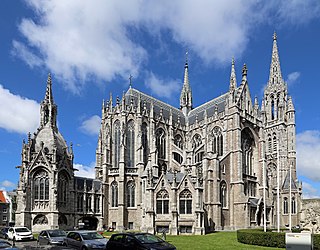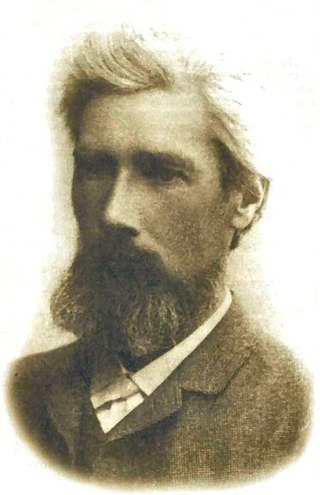This article needs additional citations for verification .(September 2014) |
| |||
|---|---|---|---|
| Buildings and structures +... |
The year 1947 in architecture involved some significant events.
This article needs additional citations for verification .(September 2014) |
| |||
|---|---|---|---|
| Buildings and structures +... |
The year 1947 in architecture involved some significant events.



Sir George Gilbert Scott, known as Sir Gilbert Scott, was a prolific English Gothic Revival architect, chiefly associated with the design, building and renovation of churches and cathedrals, although he started his career as a leading designer of workhouses. Over 800 buildings were designed or altered by him.

Gothic Revival is an architectural movement that began in the late 1740s in England. The movement gained momentum and expanded in the first half of the 19th century, as increasingly serious and learned admirers of the neo-Gothic styles sought to revive medieval Gothic architecture, intending to complement or even supersede the neoclassical styles prevalent at the time. Gothic Revival draws upon features of medieval examples, including decorative patterns, finials, lancet windows, and hood moulds. By the middle of the 19th century, Gothic had become the preeminent architectural style in the Western world, only to fall out of fashion in the 1880s and early 1890s.
This is a timeline of architecture, indexing the individual year in architecture pages. Notable events in architecture and related disciplines including structural engineering, landscape architecture, and city planning. One significant architectural achievement is listed for each year.
The year 1935 in architecture involved some significant architectural events and new buildings.
The year 1932 in architecture involved some significant events.
The year 1869 in architecture involved some significant architectural events and new buildings.
The year 1901 in architecture involved some significant events.
The year 1940 in architecture involved some significant architectural events and new buildings.
The year 1905 in architecture involved some significant architectural events and new buildings.

Richard Morris Hunt was an American architect of the nineteenth century and an eminent figure in the history of American architecture. He helped shape New York City with his designs for the 1902 entrance façade and Great Hall of the Metropolitan Museum of Art, the pedestal of the Statue of Liberty, and many Fifth Avenue mansions since destroyed.

Jože Plečnik was a Slovene architect who had a major impact on the modern architecture of Vienna, Prague and of Ljubljana, the capital of Slovenia, most notably by designing the iconic Triple Bridge and the Slovene National and University Library building, as well as the embankments along the Ljubljanica River, the Ljubljana Central Market buildings, the Ljubljana cemetery, parks, plazas etc. His architectural imprint on Ljubljana has been compared to the impact Antoni Gaudí had on Barcelona.

James Renwick Jr. was an American architect in the 19th century. The Encyclopedia of American Architecture calls him "one of the most successful American architects of his time".
The year 1948 in architecture involved some significant events.

Alfred Bult Mullett was a British-American architect who served from 1866 to 1874 as Supervising Architect, head of the agency of the United States Treasury Department that designed federal government buildings. His work followed trends in Victorian style, evolving from the Greek Revival to Second Empire to Richardsonian Romanesque.

Napoleon Eugene Charles Henry LeBrun was an American architect. He began his career in Philadelphia designing churches and theatres including St. Augustine's Church, the Cathedral-Basilica of Sts. Peter and Paul and the Philadelphia Academy of Music. He moved to New York City, established the firm Napoleon LeBrun & Sons and designed multiple additional churches. He became the official architect of the Fire Department of New York and designed 42 firehouses between 1879 and 1895. He also designed early skyscrapers in New York City such as the Metropolitan Life Insurance Company Tower and the Home Life Building.
Edward Tuckerman Potter was an American architect best known for designing the 1871 Mark Twain House in Hartford, Connecticut. With his half-brother William Appleton Potter, he also designed Nott Memorial Hall (1858–79) at his alma mater, Union College, Schenectady, New York. Both the Mark Twain House and Nott Memorial Hall are National Historic Landmarks.

Carl Pfeiffer (1834-1888) was a German American architect practicing in New York City.
Henry Engelbert (1826–1901) was a German-American architect. He was best known for buildings in the French Second Empire style, which emphasized elaborate mansard roofs with dormers. New York's Grand Hotel on Broadway is the most noteworthy extant example of Engelbert's work in this style. Many of his commissions were Lutheran or Roman Catholic churches.

Victor Alexandrovich Schröter was a prominent Russian architect of German ethnicity.

Modern Gothic, also known as Reformed Gothic, was an Aesthetic Movement style of the 1860s and 1870s in architecture, furniture and decorative arts, that was popular in Great Britain and the United States. A rebellion against the excessive ornament of Second Empire and Rococo Revival furniture, it advocated simplicity and honesty of construction, and ornament derived from nature. Unlike the Gothic Revival, it sought not to copy Gothic designs, but to adapt them abstract them, and apply them to new forms.